Quantification of Environmental Flow Requirements to Support Ecosystem Services of Oasis Areas: A Case Study in Tarim Basin, Northwest China
Abstract
:1. Introduction
2. Materials and Methods
2.1. Study Area and Classification of Environmental Flow Requirements
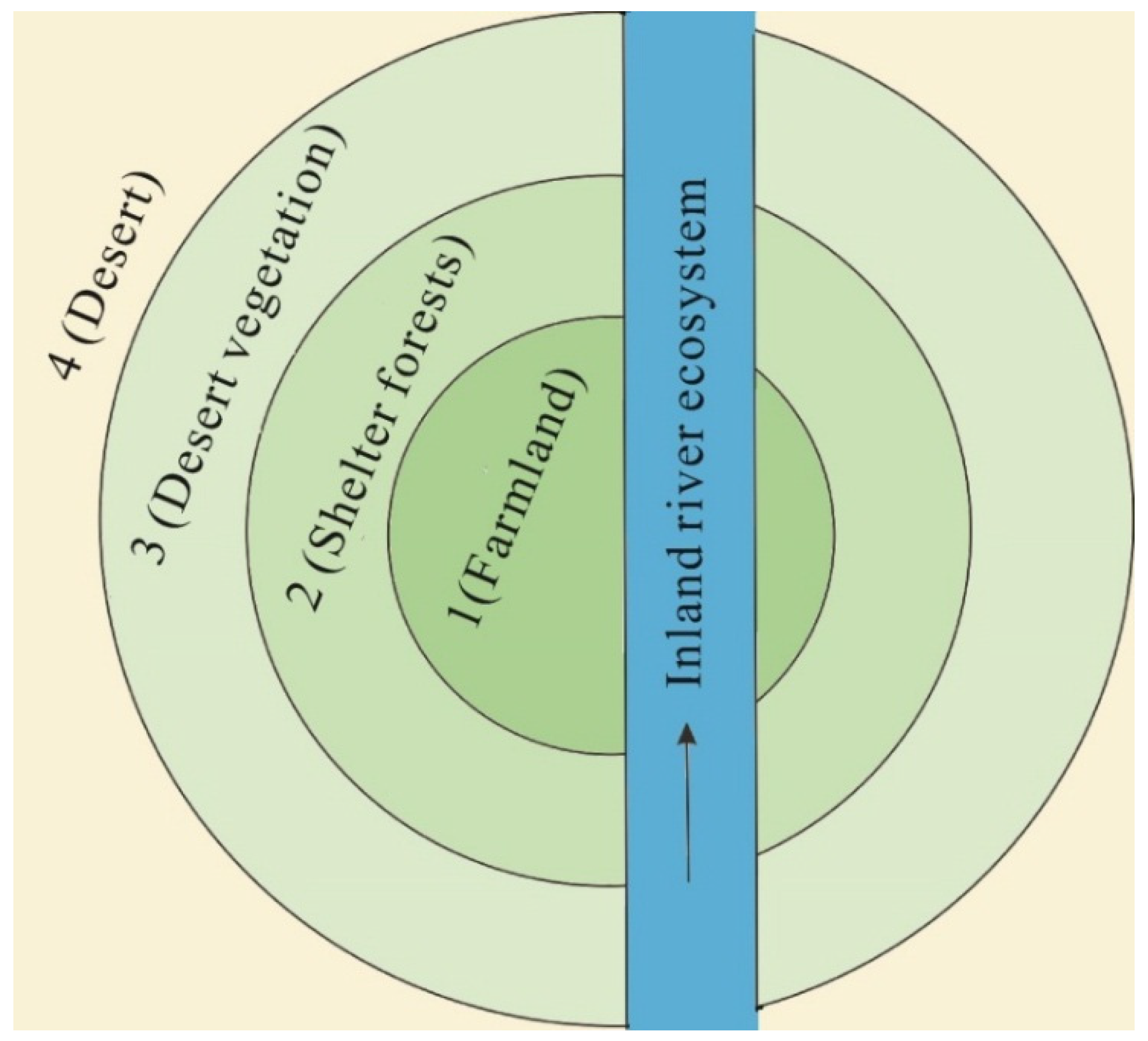
| Ecosystem Type | Environmental Flow Requirements | Ecosystem Functions |
|---|---|---|
| Riverine ecosystem | EFRs for riverine ecosystem health | Maintenance of riverine habitat |
| Sediment transport | ||
| Salinity balance | ||
| Nutrients transport | ||
| Nature oasis ecosystem | EFR for maintenance of desert vegetation | Combating desertification |
| EFRs for maintenance of riparian and shelter forests | Preventing sandstorm | |
| EFR for groundwater restoration | Ensuring desert vegetation growth |
2.2. Quantification of Environmental Flow Requirements in Oasis Areas of Tarim Basin
2.2.1. Environmental Flow Requirement for Base Flows
2.2.2. Environmental Flow Requirement for Sediment Transport
2.2.3. Environmental Flow Requirements for Evaporation of Surface Water
2.2.4. Environmental Flow Requirements for Different Vegetation Types
2.2.5. Environmental Flow Requirements for Groundwater Restoration
2.2.6. Integration of Environmental Flow Requirements for Various Ecosystem Functions
2.2.7. Temporal Allocation of Environmental Flow Requirements
2.3. Case Study Illustrating the Application of Environmental Flow Requirements in Qira Oasis
| Vegetation Type | Vegetation Cover Index | Total Area (km2) | Area (km2) | ||
|---|---|---|---|---|---|
| Maximum | Medium | Minimum | |||
| Desert vegetation | High-coverage grass (60% to 90%) | 69.34 | 62.41 | 52.01 | 41.60 |
| Medium-coverage grass (20% to 60%) | 22.54 | 13.52 | 9.02 | 4.51 | |
| Low-coverage grass (5% to 20%) | 20.28 | 4.06 | 2.54 | 1.01 | |
| Riparian and shelter forests | – | 50 | 50 | 50 | 50 |
| Total | – | 162.16 | 129.99 | 113.56 | 97.13 |

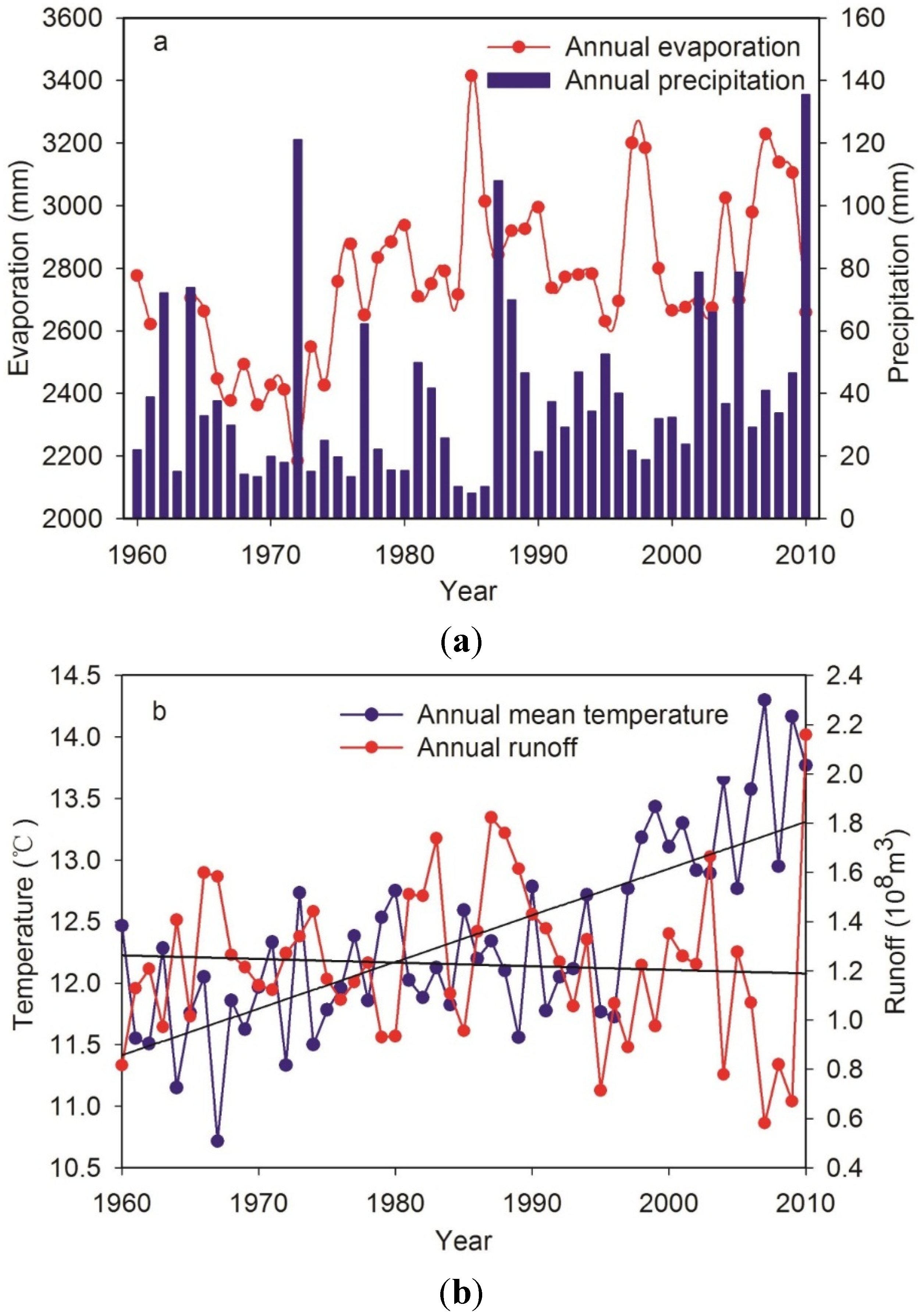
3. Results and Discussion
3.1. Quantification of Environmental Flow Requirements
| Ecological Functions | Water Quota (m3/hm2) | Maximum (108 m3) | Medium (108 m3) | Minimum (108 m3) |
|---|---|---|---|---|
| High-coverage grass | 2343.8 | 0.146 | 0.122 | 0.098 |
| Medium-coverage grass | 1486.7 | 0.020 | 0.013 | 0.007 |
| Low-coverage grass | 629.7 | 0.003 | 0.002 | 0.001 |
| Riparian and shelter forests | 3405 | 0.170 | 0.170 | 0.170 |
| Total | – | 0.339 | 0.307 | 0.276 |
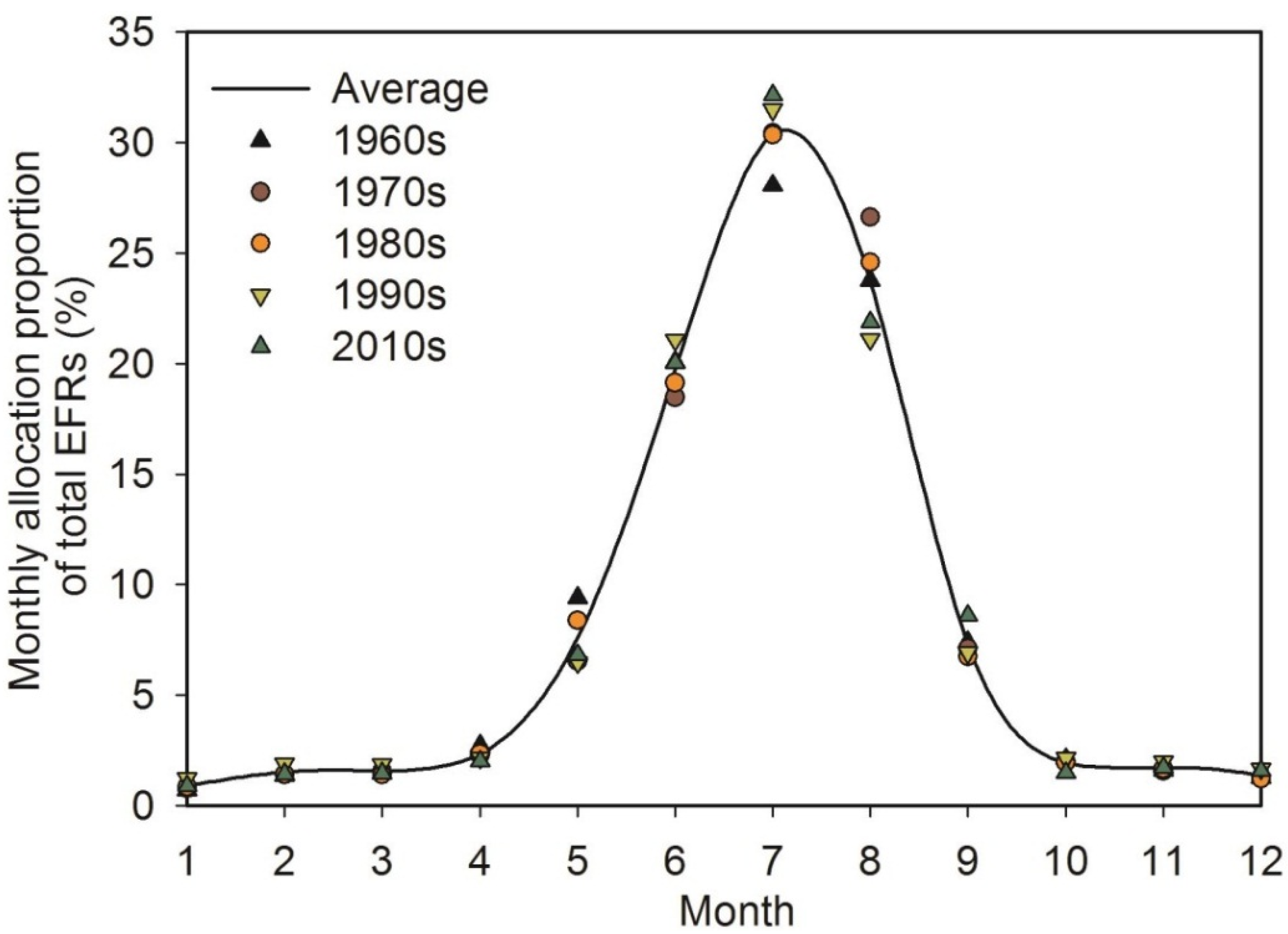
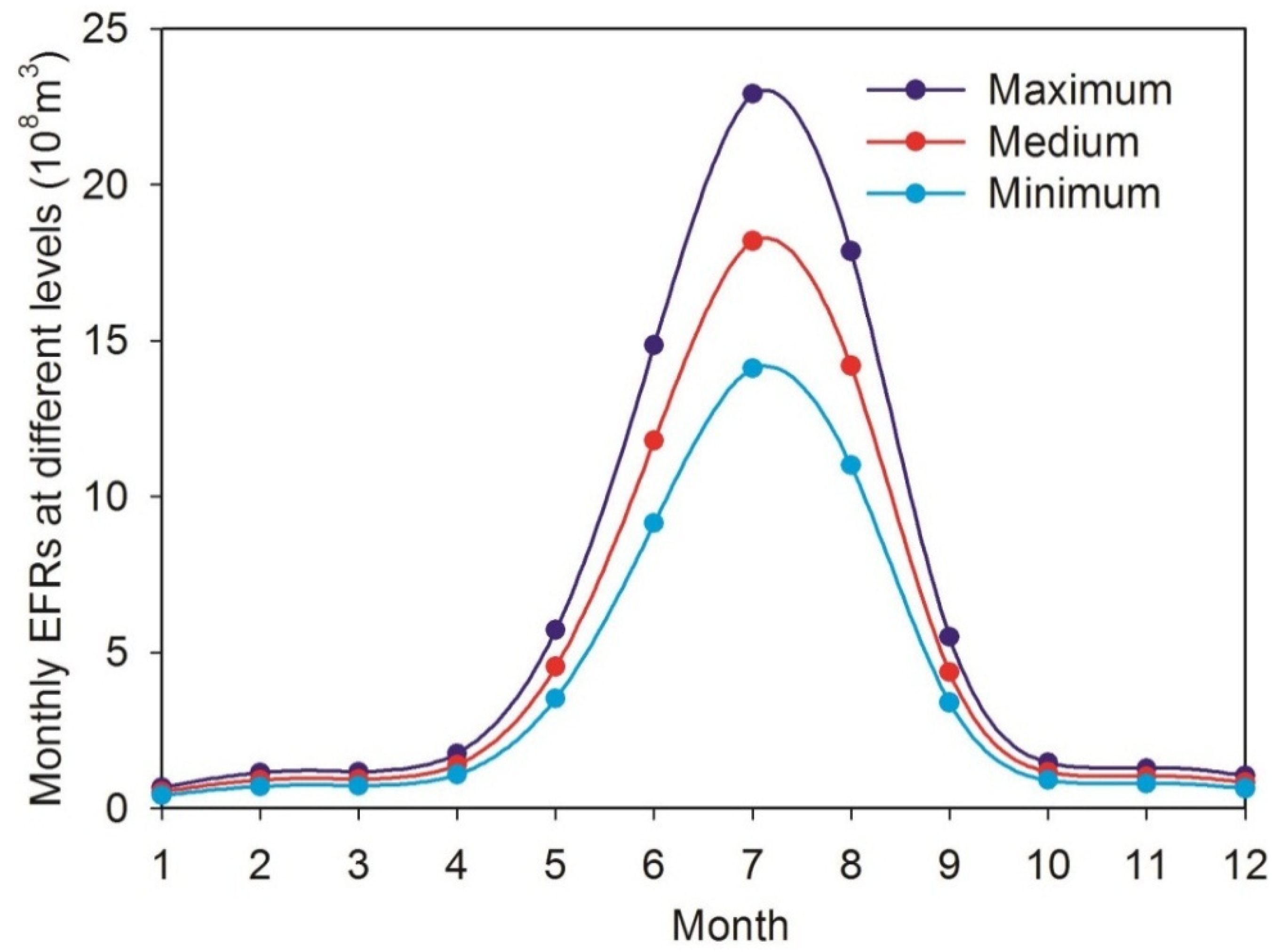
3.2. Proportion of Environmental Flow Requirements for Multiple Ecosystem Functions
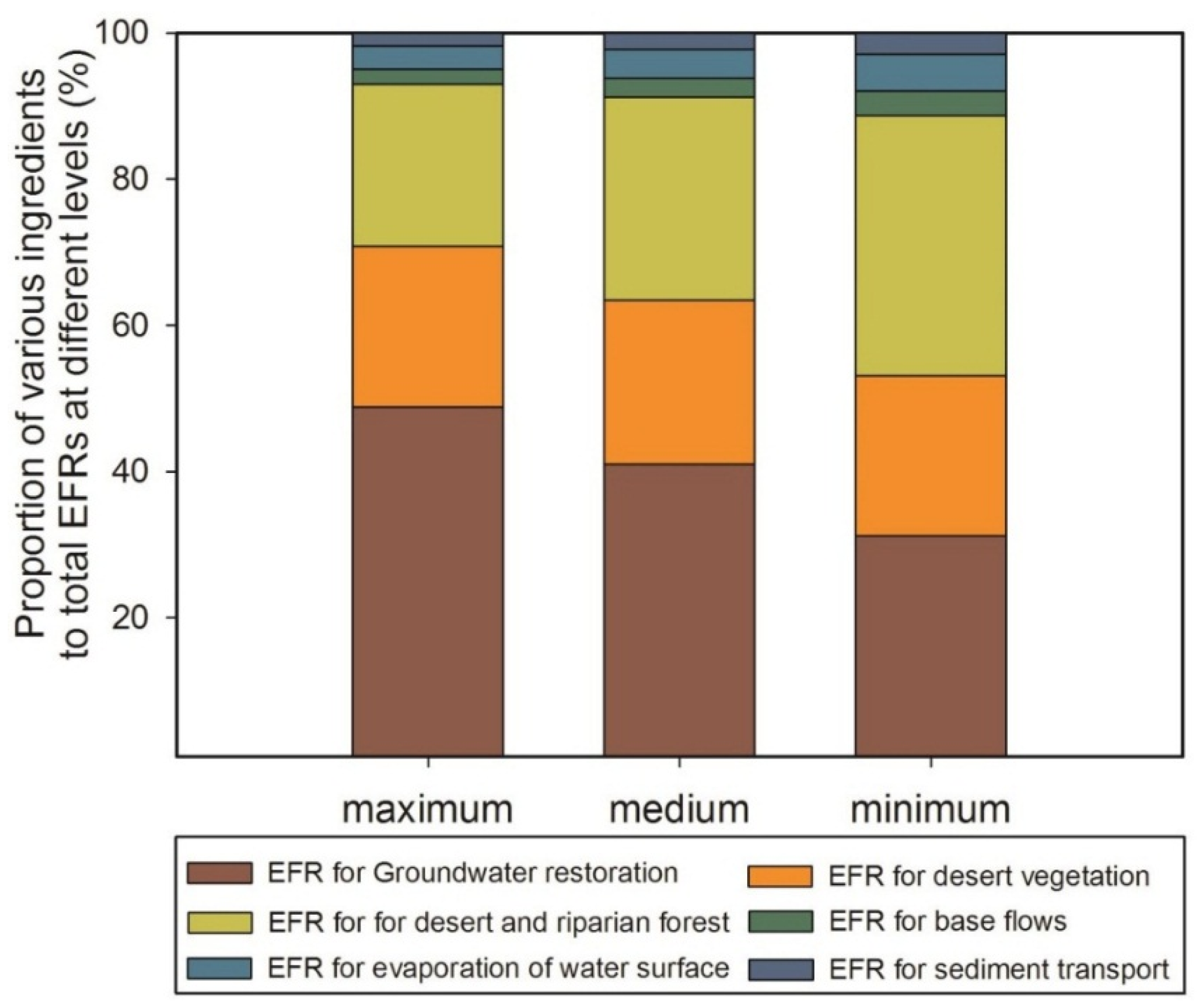
3.3. Response of Environmental Flow Requirements to Natural River Runoff
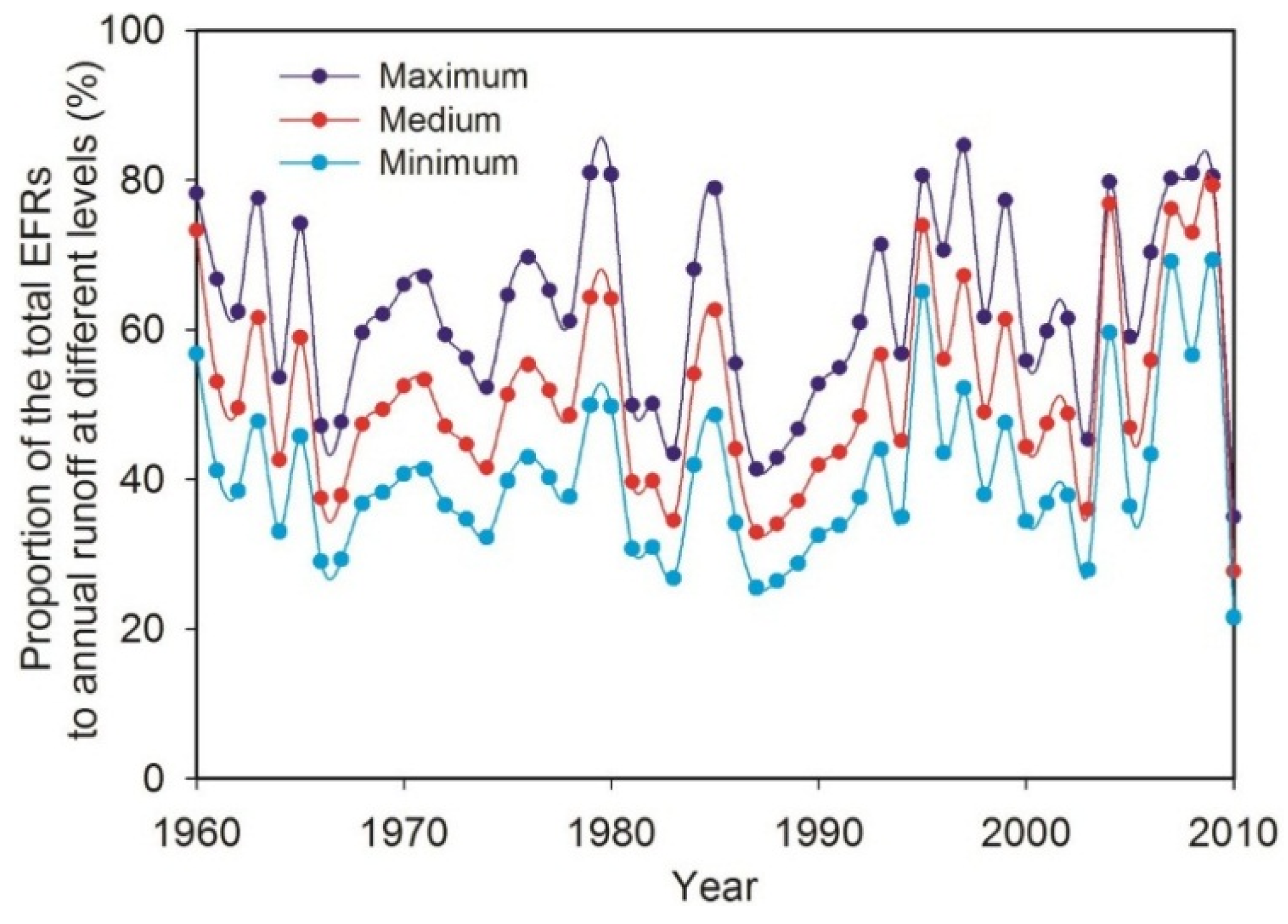
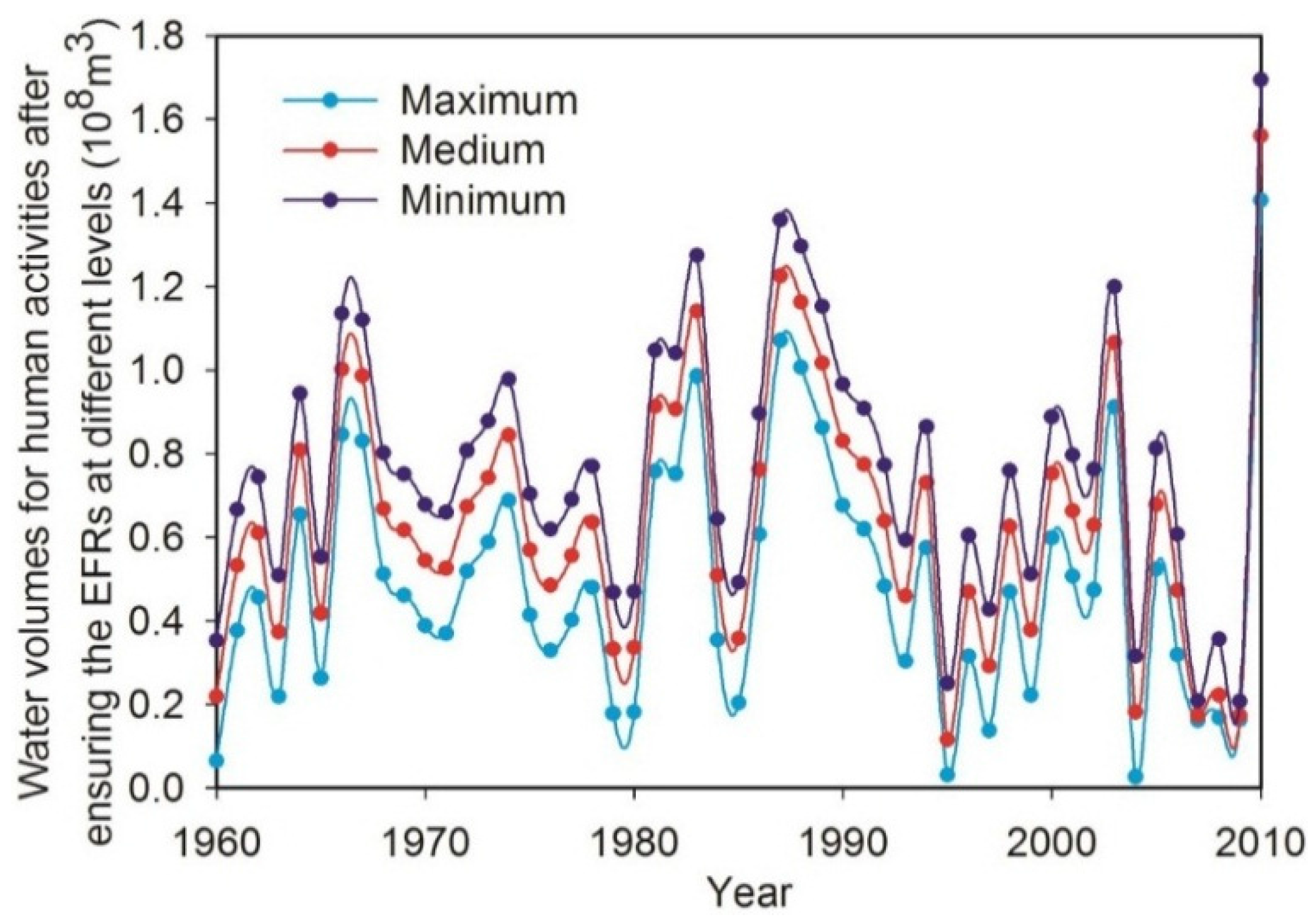
4. Conclusions
Acknowledgments
Author Contributions
Conflicts of Interest
References
- Boehmer, K.; Memon, A.; Mitchell, B. Towards sustainable water management in Southeast Asia—Experiences from Indonesia and Malaysia. Water Int. 2000, 25, 356–377. [Google Scholar] [CrossRef]
- Chen, Y.N.; Xu, Z.X. Plausible impact of global climate change on water resources in Tarim River Basin. Sci. China Ser. D 2005, 48, 65–73. [Google Scholar] [CrossRef]
- Ling, H.B.; Zhang, Q.Q.; Xu, H.L.; Shi, W. Regional climate change and its effects on the runoff of Manas River, Xinjiang, China. Environ. Earth Sci. 2011, 64, 2203–2213. [Google Scholar] [CrossRef]
- Rumbaur, C.; Thevs, N.; Disse, M.; Ahlheim, M.; Brieden, A.; Cyffka, B.; Duethmann, D.; Feike, T.; Fror, O.; Gartner, P.; et al. Sustainable management of river oases along the Tarim River (SuMaRiO) in Northwest China under conditions of climate change. Earth Syst. Dynam. 2015, 6, 83–107. [Google Scholar] [CrossRef]
- Chen, Y.N. Water Resources Research in Northwest China; Springer: Berlin, Germany, 2014; pp. 3–18. [Google Scholar]
- Ye, Z.X.; Chen, Y.N.; Li, W.H. Ecological water demand of natural vegetation in the lower Tarim River. J. Geogr. Sci. 2010, 20, 261–272. [Google Scholar] [CrossRef]
- Ling, H.B.; Xu, H.L.; Fu, J.Y.; Fan, Z.L.; Xu, X.W. Suitable oasis scale in a typical continental river basin in an arid region of China: A case study of the Manas River Basin. Quatern. Int. 2013, 286, 116–125. [Google Scholar] [CrossRef]
- Covich, A. Water and Eeosystems; Oxford University Press: NewYork, NY, USA, 1993; pp. 40–52. [Google Scholar]
- Petts, G.E. Water allocation to protect river ecosystems. Regul. Rivers Res. Manag. 1998, 12, 353–365. [Google Scholar] [CrossRef]
- Prat, N.S.; Munné, A. Water use and quality and stream flow in a Mediterranean stream. Water Res. 2000, 34, 3876–3881. [Google Scholar] [CrossRef]
- Richter, B.D.; Mathews, R.; Harrison, D.L.; Wigington, R. Ecologically sustainable water management: Managing river flows for ecological integrity. Ecol. Appl. 2003, 13, 206–224. [Google Scholar] [CrossRef]
- Cai, X.; Rosegrant, M.W. Optional water development strategies for the Yellow River Bas in: Balancing agricultural and ecological water demands. Water Resour. Res. 2004, 40, W08S04. [Google Scholar]
- Flannery, M.S.; Peebles, E.B.; Montgomery, R.T. A percent-of-flow approach for managing reductions of freshwater inflows from unimpounded rivers to the southwest Florida Estuaries. Estuaries 2002, 25, 1318–1332. [Google Scholar] [CrossRef]
- Tharme, R.E. A global perspective on environmental flow assessment emerging trends in the development and application of environmental flow methodologies for rivers. River Res. Appl. 2003, 19, 397–441. [Google Scholar] [CrossRef]
- Benetti, A.D.; Lanna, A.E.; Cobaichini, M.S. Current practices for establishing environmental flows in Brazil. River Res. Appl. 2004, 20, 427–444. [Google Scholar] [CrossRef]
- Yang, Z.F.; Sun, T.; Qin, X.S. Calculating methods for quantifying environmental flows in estuaries: A case study of Haihe River Basin, China. J. Environ. Inf. 2005, 6, 72–79. [Google Scholar] [CrossRef]
- Sun, T.; Yang, Z.F.; Cui, B.S. Critical environmental flows to support integrated ecological objectives for the Yellow River Estuary, China. Water Resour. Manag. 2008, 22, 973–989. [Google Scholar] [CrossRef]
- Yang, Z.F.; Sun, T.; Cui, B.S.; Chen, B.; Chen, G.Q. Environmental flow requirements for integrated water resources allocation in the Yellow River Basin, China. Commun. Nonlinear Sci. 2009, 14, 2469–2481. [Google Scholar] [CrossRef]
- Sun, T.; Yang, Z.F.; Shen, Z.Y.; Zhao, R. Ecological water requirements for the source region of China’s Yangtze River under a range of ecological management objectives. Water Int. 2012, 37, 236–252. [Google Scholar] [CrossRef]
- Thomas, F.M.; Foetzki, A.; Arndt, S.K.; Bruelheide, H.; Gries, D.; Li, X.; Runge, M. Water use by perennial plants in the transition zone between river oasis and desert in NW China. Basic Appl. Ecol. 2006, 7, 253–267. [Google Scholar] [CrossRef]
- Tang, Q.C.; Chen, H.Y. Water resources and oasis construction in Tarim Basin. Chin. Geogra. Sci. 1992, 2, 173–182. [Google Scholar] [CrossRef]
- CAWA. Regional Research Network-Central Asian Water. Available online: http://www.cawa-project.net/ (accessed on 5 March 2015).
- Abd EI-Ghani, M.M. Flora and vegetation of Gara oasis, Egypt. Phytocoenol 1992, 21, 1–14. [Google Scholar]
- Hu, S.J.; Song, Y.D.; Tian, C.Y.; Li, Y.T.; Li, X.C.; Chen, X.B. Suitable scale of Weigan River plain oasis. Sci. China Ser. D 2007, 50, 56–64. [Google Scholar] [CrossRef]
- Malano, H.M.; Davidson, B.A. Framework for assessing the trade-off between economic and environmental uses of water in a river basin. Irrig. Drain. 2009, 58, 133–147. [Google Scholar] [CrossRef]
- Wang, F.; Liang, R.L.; Yang, X.L.; Chen, M.J. A study of ecological water requirements in northwest China: Theoretical analysis. J. Nat. Resour. 2002, 17, 1–8. (in Chinese). [Google Scholar]
- Song, Y.D.; Fan, Z.L.; Lei, Z.D.; Zhang, F.W. Research On Water Resources And Ecology Of Tarim River, China; Volksverlag Xinjiang: Urumqi, China, 2000; pp. 400–406. [Google Scholar]
- Wang, R.H.; Lu, X.M.; Song, Y.D.; Fan, Z.L.; Ma, Y.J. Patterns and characteristics of ecological water demand in west arid zone of China—A case study of green corridor in the lower reaches of Tarim River. Chin. J. Appl. Ecol. 2003, 14, 520–524. (in Chinese). [Google Scholar]
- Fan, Z.L.; Ma, Y.J.; Zhang, H.; Wang, R.H.; Zhao, Y.J.; Zhou, H.F. Research of eco-water table and rational depth of groundwater of Tarim river Drainage Basin. Arid Land Geogr. 2004, 27, 8–13. (in Chinese). [Google Scholar]
- Liu, B.; Zhao, W.Z.; Chang, X.X.; Li, S.B.; Zhang, Z.H.; Du, M.W. Water requirements and stability of oasis ecosystem in arid region, China. Environ. Earth Sci. 2010, 59, 1235–1244. [Google Scholar] [CrossRef]
- Wu, J.L.; Yang, F.X.; Zhou, J.; Zhang, Z.W. Desert types and characteristics in the Qira River Basin. Arid Land Geogr. 2013, 36, 803–811. (in Chinese). [Google Scholar]
- Wu, Y.W.; Yang, F.X.; Hua, T. Landforms and their effects on ecological pattern in the Qira River Basin. Arid Zone Res. 2011, 28, 355–362. (in Chinese). [Google Scholar]
- Shi, Y.F.; Shen, Y.P.; Kang, E.S.; Li, D.L.; Ding, Y.J.; Zhang, G.W.; Hu, R.J. Recent and future climate change in Northwest China. Clim. Chang. 2007, 80, 379–393. [Google Scholar] [CrossRef]
- Congalton, R.G.; Green, K. Assessing the Accuracy of Remotely Sensed Data: Principals and Practices; CRC Press: London, UK, 1999; pp. 137–145. [Google Scholar]
- The project SuMaRiO. Sustainable Management of River Oases Along the Tarim River. Available online: http://www.sumario.de/ (accessed on 15 March 2015).
- Zhang, F. Water Resource Variation and Its Effects on landscape changes Research in Qira Oasis; Xinjiang University: Urumqi, China, 2003. [Google Scholar]
- Bruelheide, H.; Jandt, U.; Gries, D.; Thomas, F.M.; Foetzki, A.; Buerkert, A.; Wang, G.; Zhang, X.M.; Runge, M. Vegetation changes in a river oasis on the southern rim of the Taklamakan Desert in China between 1956 and 2000. Phytocoenologia 2003, 33, 801–818. [Google Scholar] [CrossRef]
- Chen, Y.N.; Li, W.H.; Xu, H.L.; Liu, J.Z.; Zhang, H.F.; Chen, Y.P. The influence of groundwater on vegetation in the lower reaches of Tarim River, China. Acta Geogr. Sin. 2003, 58, 542–549. [Google Scholar]
- Cui, Y.L.; Shao, J.L. The role of ground water in arid/semiarid ecosystems, Northwest China. Groundwater 2005, 43, 471–477. [Google Scholar] [CrossRef] [PubMed]
- Andrea, F.; Acreman, M.; Dunbar, M.J. Defining environmental river flow requirements: A review. Hydrol. Earth Syst. Sci. 2004, 8, 861–876. [Google Scholar]
- Yates, D.N.; Sieber, J.; Purkey, D.; Huber, A. WEAP21—A demand-, priority-, and preference-driven water planning model part 1: Model characteristics. Water Int. 2005, 30, 487–500. [Google Scholar] [CrossRef]
- Wei, Y.P.; Davidson, B.; Chen, D.L.; White, R.E. Balancing the economic, social and environmental dimensions of agro-ecosystems: An integrated modeling approach. Agr. Ecosyst. Environ. 2009, 131, 263–273. [Google Scholar] [CrossRef]
- Pang, A.P.; Sun, T.; Yang, Z.F. A framework for determining recommended environmental flows for balancing agricultural and ecosystem water demands. Hydrol. Sci. J. 2014, 59, 890–903. [Google Scholar] [CrossRef]
- Ran, B.Q.; Xu, F.R.; Zhang, C.L. Review of research and practice of river basin ecological compensation. J. Hydraul. Eng. 2008, 39, 1220–1225. [Google Scholar]
- Liu, Y.L.; Hu, P. Ecological compensation standard for Xinjiang River basin based on Pareto optimization. J. Hydraul. Eng. 2009, 40, 703–713. [Google Scholar]
- Sisto, N.P. Environmental flows for rivers and economic compensation for irrigators. J. Environ. Manag. 2009, 90, 1236–1240. [Google Scholar] [CrossRef] [PubMed]
© 2015 by the authors; licensee MDPI, Basel, Switzerland. This article is an open access article distributed under the terms and conditions of the Creative Commons Attribution license (http://creativecommons.org/licenses/by/4.0/).
Share and Cite
Xue, J.; Gui, D.; Zhao, Y.; Lei, J.; Feng, X.; Zeng, F.; Zhou, J.; Mao, D. Quantification of Environmental Flow Requirements to Support Ecosystem Services of Oasis Areas: A Case Study in Tarim Basin, Northwest China. Water 2015, 7, 5657-5675. https://doi.org/10.3390/w7105657
Xue J, Gui D, Zhao Y, Lei J, Feng X, Zeng F, Zhou J, Mao D. Quantification of Environmental Flow Requirements to Support Ecosystem Services of Oasis Areas: A Case Study in Tarim Basin, Northwest China. Water. 2015; 7(10):5657-5675. https://doi.org/10.3390/w7105657
Chicago/Turabian StyleXue, Jie, Dongwei Gui, Ying Zhao, Jiaqiang Lei, Xinlong Feng, Fanjiang Zeng, Jie Zhou, and Donglei Mao. 2015. "Quantification of Environmental Flow Requirements to Support Ecosystem Services of Oasis Areas: A Case Study in Tarim Basin, Northwest China" Water 7, no. 10: 5657-5675. https://doi.org/10.3390/w7105657
APA StyleXue, J., Gui, D., Zhao, Y., Lei, J., Feng, X., Zeng, F., Zhou, J., & Mao, D. (2015). Quantification of Environmental Flow Requirements to Support Ecosystem Services of Oasis Areas: A Case Study in Tarim Basin, Northwest China. Water, 7(10), 5657-5675. https://doi.org/10.3390/w7105657







